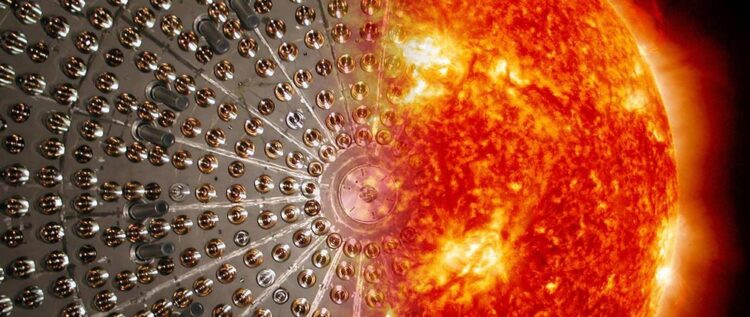Sun model completely confirmed for the first time

With the Borexino detector, a physics team has succeeded in detecting neutrinos from the sun's second fusion process.
Image: Borexino Collaboration
Borexino detector succeeds in measuring the sun’s CNO fusion cycle.
Proof for the fusion cycle postulated in the 1930s
This second cycle was postulated as another source of the sun’s energy in the 1930s by physicists Hans Bethe and Carl Friedrich von Weizsäcker independently of one another, but could not be experimentally confirmed until now.
Physicists working on the Borexino Experiment in the underground laboratory deep below the Italian Gran Sasso massif have now succeeded for the first time in proving the presence of this cycle based on the neutrinos it produces.
Several years ago the Borexino Experiment team presented for the first time an overall investigation of the fusion processes of the pp chain using its neutrinos. Scientists from the physics department of the Technical University of Munich (TUM) were centrally involved both measurement processes.
Interference obscured the signal until now
Because of their energy distribution, the neutrinos of the CNO cycle were difficult to distinguish from those generated by the radioactive decay of tiny traces of other elements. Primarily bismuth-210 from trace impurities on the surface of the detector wall were responsible for concealing the signals of the CNO cycle.
Due to convection movements, these contaminants got into the detector liquid. In order to eliminate the disturbance, the convection inside the Borexino detector had to be brought to a standstill, which was technically extremely elaborate.
“For a long time I thought it would never be possible to successfully make this measurement,” says Stefan Schönert, Professor for Experimental Astroparticle Physics at TU Munich. “But six years of hard work have paid off and now we’ve proven the presence of the CNO neutrino signal for the first time.”
New evidence on the metallicity of the sun
These results confirm not only the theoretical predictions on the sun’s two fusion processes, they also provide evidence regarding the metallicity of the sun, i.e. the concentration levels of nuclei which are heavier than hydrogen and helium.
Different astrophysical investigative methods have generated differing results in past years. “The new Borexino results now support observations with higher metallicity values,” says Prof. Lothar Oberauer of TUM.
This is particularly important in the context of the fundamental properties of stars such as their size, temperature, brightness and lifetime, which are determined by the degree of metallicity. Understanding the chemical composition of the sun is therefore essential to understanding the properties of all stars.
Publications:
The Borexino Collaboration:
Experimental evidence of neutrinos produced in the CNO fusion cycle in the Sun.
Nature, 587, 577–582 (2020) – DOI: 10.1038/s41586-020-2934-0
More information:
- The Borexino Experiment is based in the Laboratori Nazionali del Gran Sasso (Italy) and was launched in 2007. Research groups from Germany, Italy, France, Poland, Russia and the USA work together on the Borexino Experiment team. In Germany the following institutions are participating: Technical University of Munich (TUM), Forschungszentrum Jülich, Johannes Gutenberg University Mainz, Technical University of Dresden and RWTH Aachen University.
- The Borexino program is funded by Istituto Nazionale di Fisica Nucleare (INFN) (Italy), National Science Foundation (NSF) (USA), Deutsche Forschungsgemeinschaft (DFG) and Helmholtz-Gemeinschaft (HGF) (Germany), Russian Foundation for Basic Research (RFBR) and Russian Science Foundation (RSF) (Russia), and Narodowe Centrum Nauki (NCN) (Poland). Computing time was provided by the computing services of Bologna INFNCNAF datacenter, the U-Lite Computing Center and Network Service at LNGS (Italy) as well as the supercomputer JURECA 44 at Forschungszentrum Jülich Germany).
Contacts to this article:
Technical University of Munich
Professorship of Experimental Astro-Particle Physics
James-Franck-Str. 1, 85748 Garching
Prof. Dr. Stefan Schönert
Tel.: +49 89 289 12511
schoenert(at)ph.tum.de
Prof. Dr. Lothar Oberauer
Tel.: +49 89 289 12509
lothar.oberauer(at)tum.de
https://www.tum.de/nc/en/about-tum/news/press-releases/details/36337/
Media Contact
All latest news from the category: Physics and Astronomy
This area deals with the fundamental laws and building blocks of nature and how they interact, the properties and the behavior of matter, and research into space and time and their structures.
innovations-report provides in-depth reports and articles on subjects such as astrophysics, laser technologies, nuclear, quantum, particle and solid-state physics, nanotechnologies, planetary research and findings (Mars, Venus) and developments related to the Hubble Telescope.
Newest articles

Retinoblastoma: Eye-Catching Investigation into Retinal Tumor Cells
A research team from the Medical Faculty of the University of Duisburg-Essen and the University Hospital Essen has developed a new cell culture model that can be used to better…

A Job Well Done: How Hiroshima’s Groundwater Strategy Helped Manage Floods
Groundwater and multilevel cooperation in recovery efforts mitigated water crisis after flooding. Converting Disasters into Opportunities Society is often vulnerable to disasters, but how humans manage during and after can…

Shaping the Future: DNA Nanorobots That Can Modify Synthetic Cells
Scientists at the University of Stuttgart have succeeded in controlling the structure and function of biological membranes with the help of “DNA origami”. The system they developed may facilitate the…



